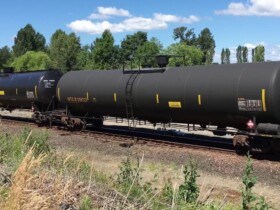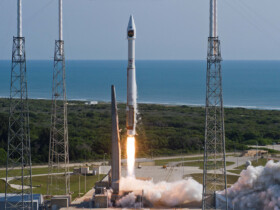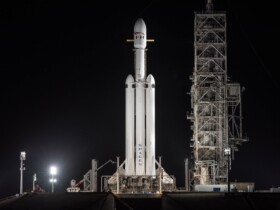Return of F-1?
On April 18, 2012, Huntsville, Alabama’s Dynetics Inc. and Pratt & Whitney Rocketdyne (PWR) announced plans to partner to compete for the NASA Space Launch System (SLS) Advanced Booster Engineering Demonstration and/or Risk Reduction (ABEDRR) procurement, with Dynetics serving as the proposal lead. Dynetics and PWR propose use of a derivative of Rocketdyne’s F-1 that powered NASA’s Saturn 5 rocket during the Apollo program.
The project, planned to run from October, 2012 through early 2015, is intended to reduce booster development risk. $200 million may be awarded to one or more contractors, whose work will likely result in hardware demonstrations, including some component hotfire testing. The contract will set the stage for full-scale booster design and development.
According to Steve Cook, Dynetics drector of space technologies, use of F-1 powered boosters would provide about 20 tonnes more lift capacity to low Earth orbit over the SLS baseline solid rocket boosters. Plans call for two of the 1.8 million pound thrust engines to power each liquid booster, a thrust consistent with the F-1A engine demonstrated by Rocketdyne near the end of the Apollo program but never flown.
In addition to Dynetics and PWR, ATK is expected to propose an advanced solid booster, and a team consisting of Huntsville’s Teledyne Brown and Aerojet is expected to propose an upgraded NK-33 variant known as “AJ-26-500” that would produce 500,000 pounds of sea level thrust.
SLS Advanced Booster resulted from a Congressional requirement for early SLS booster competition. ATK’s five segment PBAN booster, developed for Ares 1, is expected to be used only for the first few SLS “Block 1” flights. Meanwhile, the Advanced Booster competition for powering SLS Block 1A and Block 2 would be open to both solid and liquid booster designs. Block 1A would add Advanced Boosters to the Block 1 core to increase low earth orbit (LEO) payload from 70 to 105 tonnes. Block 2 would add a second stage to the Block 1A vehicle to reach 130 tonne LEO capability.
The Block Skip

Use of F-1A powered boosters offers a compelling possibility, and one that is not likely part of NASA’s plan. If properly sized, an SLS powered by such boosters could likely reach the 130 tonne limit without an upper stage. NASA could achieve Block 2 performance without having to pay for the costly devleopment of an upper stage and its J-2X engine. The trade would be a liquid booster that would likely cost more than its lower performing solid booster alternative.
The only problem is that NASA hasn’t specified such a booster. It has asked bidders to work on designs that could allow SLS Block 2, a 2.5 stage design, to reach 130 tonnes. While such a specification would push solid booster technology, liquid boosters could meet the goal with little trouble. But by making the liquids a little bigger, and allowing them to carry more propellant than needed for a 2.5 stage Block 2 design, they might achieve the impressive 1.5 stage 130 tonne result.
Liquid boosters offer other well known benefits. Their use would remove hazardous restrictions placed on the Vehicle Assembly Building by the presence of loaded solid rocket booster segments. They would remove 1,150 tonnes of mass from the rollout stack, reducing loading on the crawler transporters and on the crawlerway. They would likely improve performance, or ease implementation, of crew launch escape systems. But performance improvement may be the strongest argument for use of liquid boosters.
Also read: NASA’s Space Launch System Formally Announced
Design Possibilities

SLS Block 1A is supposed to lift at least 105 tonnes to LEO. An F-1A powered liquid booster pair would need to carry about 550 tonnes of propellant apiece to reach that goal. That amount can easily be packaged within NASA’s booster size limits.
VAB restrictions limit liquid boosters to about 5.5 meters diameter and 71 meters in height. (Five segment boosters, by comparison, only stand 54 meters and are 3.72 meters in diameter.) A kerosene/LOX booster that used two separate propellant tanks, stood 54 meters tall, and was 5.5 meters diameter would likely be able to carry nearly 840 tonnes of propellant. A 71 meter tall booster would be able to carry more than 960 tonnes of propellant. Such larger loadings could allow the 130 tonne goal to be reached without an upper stage.
Liquid boosters would have to support the same load path as the five segment booster, transferring most of their force through a forward attach point, 47.92 meters from the bottom of the booster, to the thrust beam that passes through the core intertank section.
These requirements add dry mass, but analysis suggests that the 130 tonne goal is acheivable even with a booster propellant mass fraction (loaded propellant mass divided by total booster mass) as low as 0.90. This compares to 0.94 for the Saturn 5 S-IC stage, 0.93 for an Atlas 5 CCB, 0.917 for a Zenit 2 first stage (a rocket designed to boost the USSR’s Energia), and 0.905 for the First Lunar Outpost “Comet” dual F-1A powered booster studied during the early 1990s.
In a hypothetical design studied for this report, two kerosene/LOX liquid boosters, each powered by two Rocketdyne F-1A engines, would produce 3,263 tonnes of liftoff thrust and 3,630 tonnes of thrust in vacuum. Their specific impluse would be 269.6 seconds at sea level and 303.1 seconds in vacuum. Together, the boosters would weigh 2,000 tonnes at liftoff and 218 tonnes at burnout. (Compare this to 1,460 tonnes and 207 tonnes, respectively, for five segment booster.)
The core would be the SLS Block 1 core, powered by four RS-25 engines that would make 758 tonnes of liftoff thrust and 930 tonnes in vacuum. Their specific impulse would be 366 seconds at sea level and 452 seconds in vacuum. The core would weigh 1,068 tonnes at liftoff and 89 tonnes at burnout.
The 130 tonne payload would be housed inside an 11 tonne payload fairing. At liftoff, the vehicle would weigh 3,208 tonnes, resulting in a 1.25 thrust to weight ratio.
The boosters would burn for 150 seconds, pushing the stack to about 4g, a maximum value that could be limited by core engine throttling. Upon booster cutoff and jettison, the core would have a positive thrust to weight ratio. It would continue to burn for at least another 326 seconds after staging, with g-forces again limited to 4g or less by engine throttling.
This combination would produce more than 9,300 meters per second ideal delta-v, which should be more than enough for LEO. The cutoff would be targeted to drop off the core at just suborbital velocity, allowing it to be dropped into the Indian or Pacific Oceans. The payload would provide the final small delta-v increment to achieve a stable orbit.
| Space Launch System Details (Subject to Change) | ||||
| SLS Block 1 2011 Baseline | SLS Block 1 with ICPS | SLS Block 1A (1.5 Stg) SLS Block 2 (2.5 Stg) | Hypothetical SLS Block 1A (1.5 Stg) | |
| Boosters (Each) | 5 Segment | 5 Segment | New Boosters Liquid or Solid | 2xF-1A Liquid Boosters |
| GLOW (tonnes) | 729.8 t | 729.8 t | 751.22 t | 1,000 t |
| Propellant Mass (tonnes) | 626.10 t | 626.10 t | 650.87 t | 874 t |
| Burnout Mass (tonnes) | 103.7 t | 103.7 t | 100.33 t | 135 t |
| Diameter (meters) | 3.71 m | 3.71 m | 3.71 m | 5.49 m |
| Height (meters) (to top of frustum) | 53.87 m | 53.87 m | 53.87 m | ~66 m |
| Liftoff Thrust (vac. tonnes) | 1,592.47 t | 1,592.47 t | 1,578.6 t | 1,631.5 t |
| Specific Impulse (sea level/vacuum, seconds) | 237s/267.4 s | 237s/267.4 s | 237s/265.5 s | 269.6s/303.1 s |
| Burn Time (sec) | 126.6 s | 126.6 s | 132.5 s | 150 s |
| Propellant | PBAN | PBAN | HTPB (Example Case) | RP/LOX |
| Core Stage | 4xRS25D | 4xRS25D | 4xRS25E | 4xRS25E |
| GLOW (tonnes) | 1,068.3 t | 1,068.3 t | 1,068.3 t | 1,068.3 t |
| Usable Propellant Mass (tonnes) | 978.9 t | 978.9 t | 978.9 t | 978.9 t |
| Burnout Mass (tonnes) | 89.38 t | 89.38 t | 89.38 t | 89.38 t |
| Dry Mass (tonnes) | 76.12 t | 76.12 t | 76.12 t | 76.12 t |
| Diameter (meters) | 8.384 m | 8.384 m | 8.384 m | 8.384 m |
| Height (meters) | 62.54 m | 62.54 m | 62.54 m | 62.54 m |
| Thrust (sea level/vacuum, tonnes) | 758.4 t/929.6 t | 758.4 t/929.6 t | 758.4 t/929.6 t | 758.4 t/929.6 t |
| Specific Impulse (sea level/vacuum., seconds) | 366 s/452.1 s | 366 s/452.1 s | 366 s/452.1 s | 366 s/452.1 s |
| Burn Time (sec) | 476 s | 476 s | 476 s | 476 s |
| Propellants | LOX/LH2 | LOX/LH2 | LOX/LH2 | LOX/LH2 |
| Second Stage | Interim Cryogenic Propulsion Stage (Delta 4 Heavy Upper Stage Assumed) | Large Upper Stage 3xJ-2X (NASA 2011 Example) | ||
| GLOW (tonnes) | 30.55 t | ~237 t | ||
| Usable Propellant Mass (tonnes) | 27.2 t | ~213 t | ||
| Burnout Mass (tonnes) | ~0.3-0.4 t | ~24 t | ||
| Dry Mass (tonnes) | 3.35 t | ~19.95 t | ||
| Diameter (meters) | 5.1 m | 8.384 m | ||
| Height (meters) (including interstage) | 13.7 m | ~23 m (TBD) | ||
| Thrust (vac., tonnes) | 11.2 t | 266.44 t | ||
| Specific Impulse (vac., seconds) | 460.4 s | 448 s | ||
| Burn Time, seconds | 1,118 s | 240 s | ||
| Propellants | LOX/LH2 | LOX/LH2 | ||
| Payload Fairing | ||||
| Dry Mass (tonnes) | ~10.6 t | ~7 t | ~10.6 t | ~11 t |
| SLS Totals | ||||
| GLOW (tonnes) | ~2,650 t | ~2,650 t | ~2,700 t/2,950 t | ~3,208 t |
| Height (meters)(including payload) | 92.3 m | 97.56 m | ~113 m | ~100 m |
| Height (meters) (not including payload) | 64.7 m | 64.7 m | ~87 m | ~66 m |
| Payload (tonnes) to 48 x 296 km x 28.5 deg | >70t (~95 t likely) | ~105 t/145 t | ~130 t | |
| Payload (tonnes) to TLI | 24.5 t | ~45 t/60 t |
















Got a Questions?
Find us on Socials or Contact us and we’ll get back to you as soon as possible.